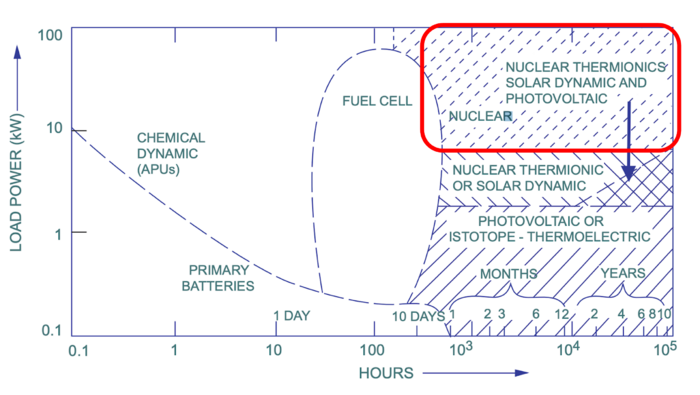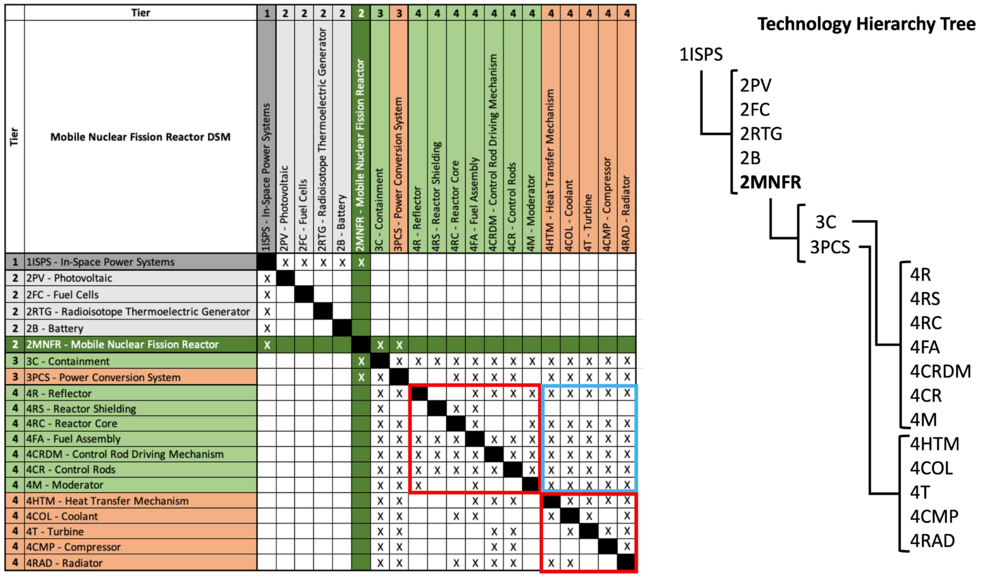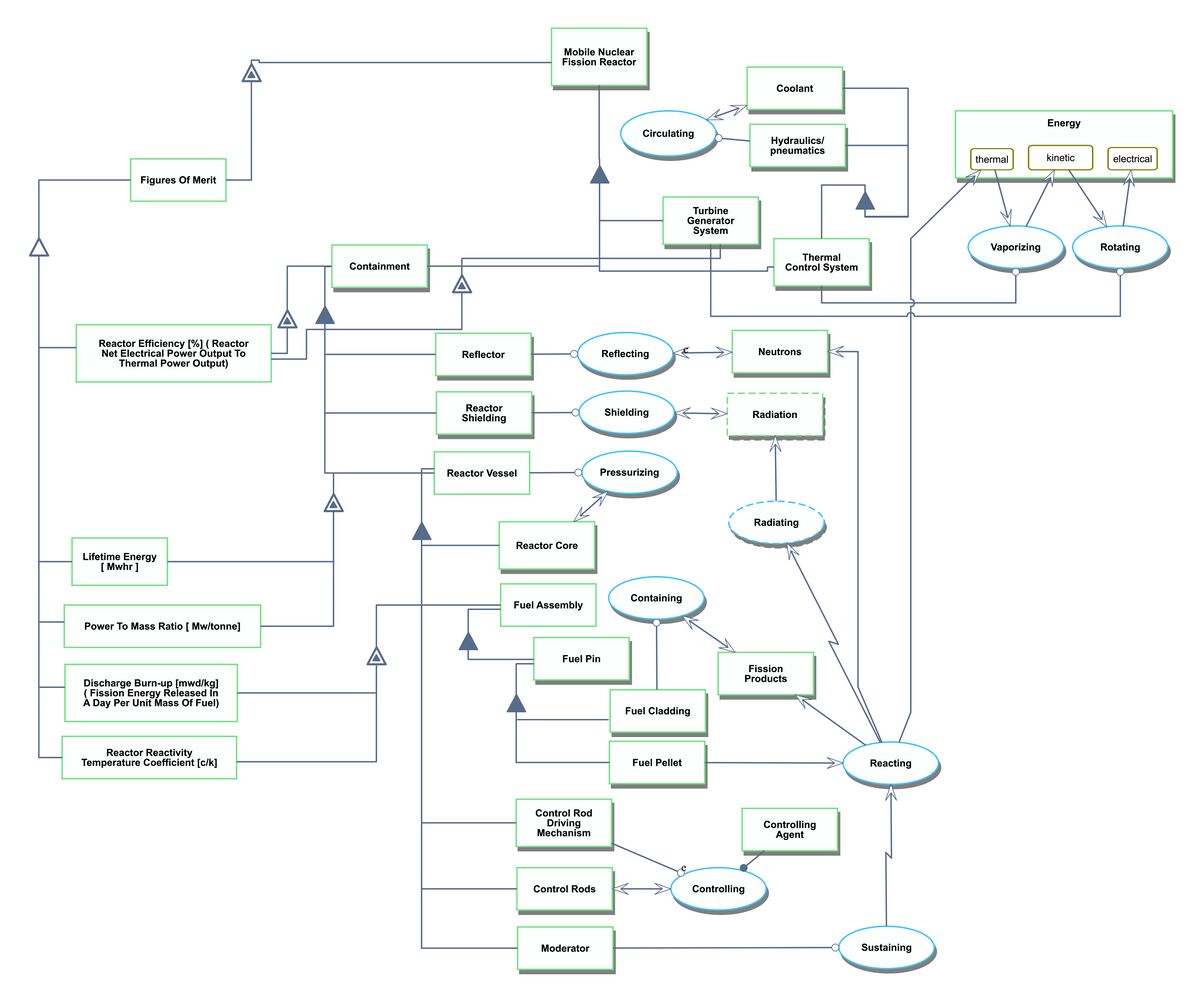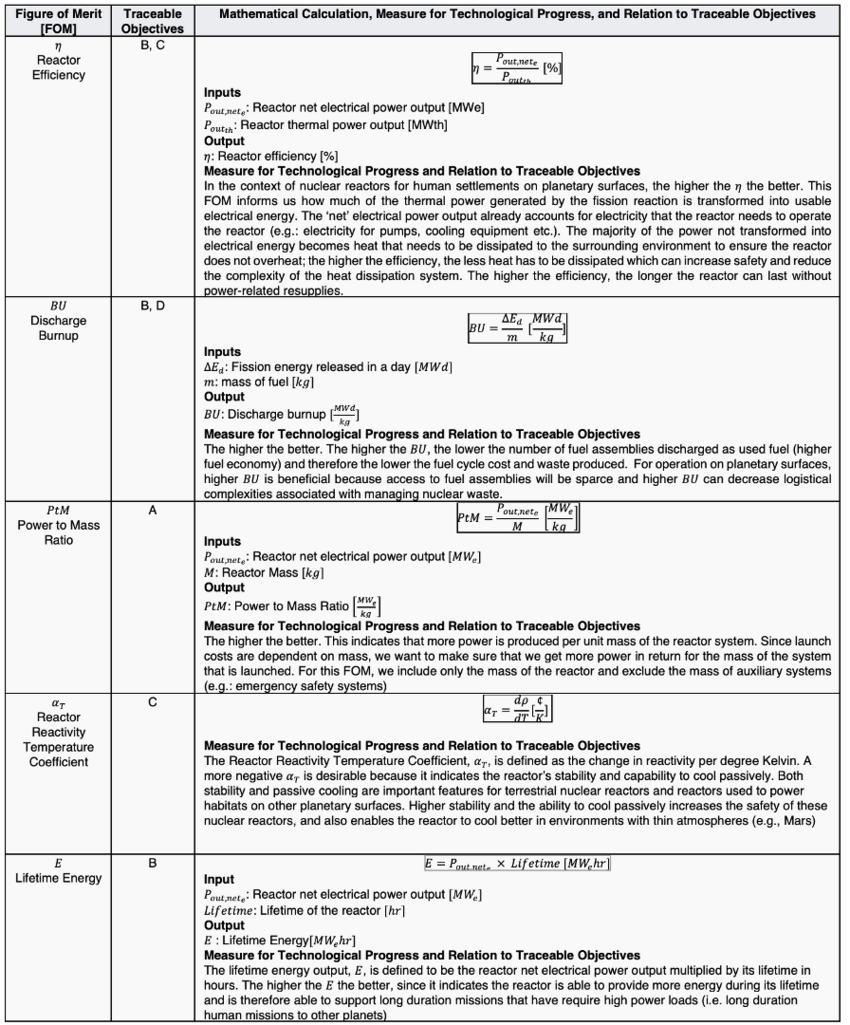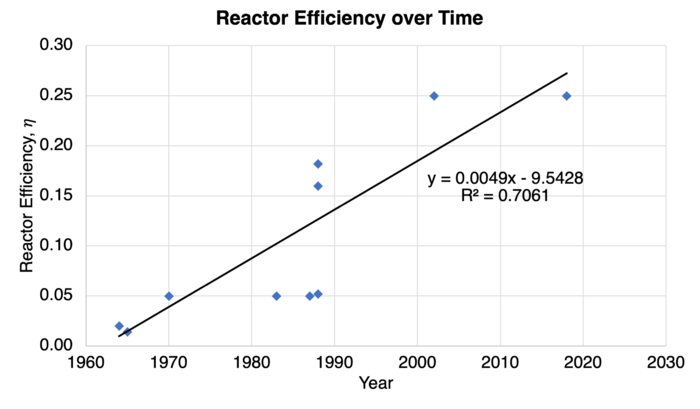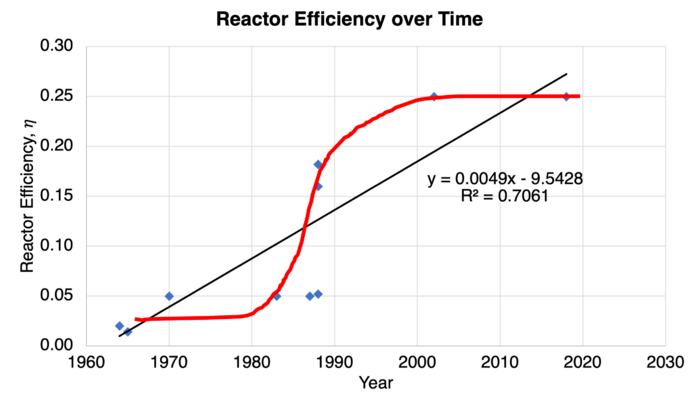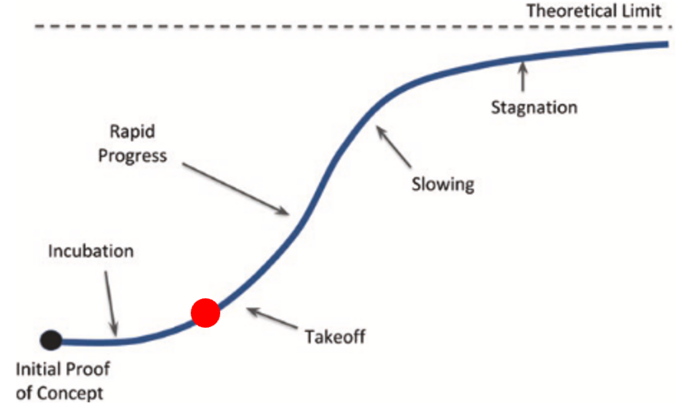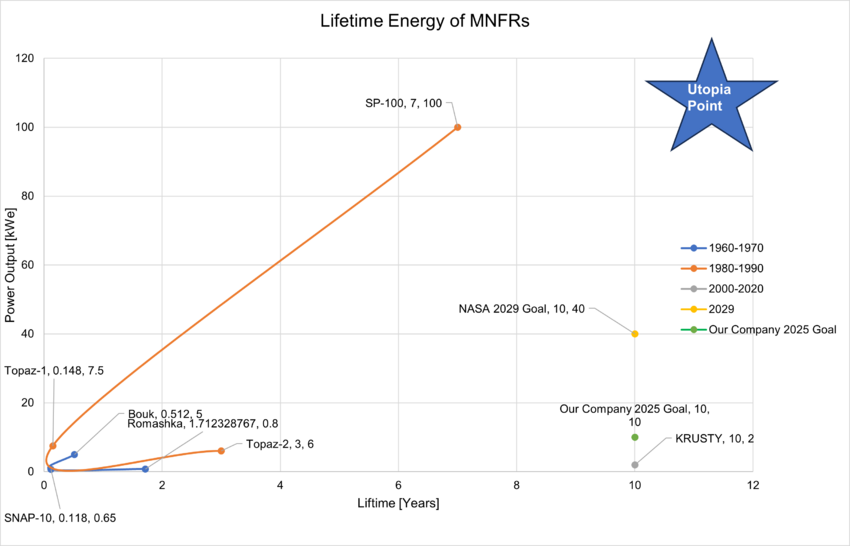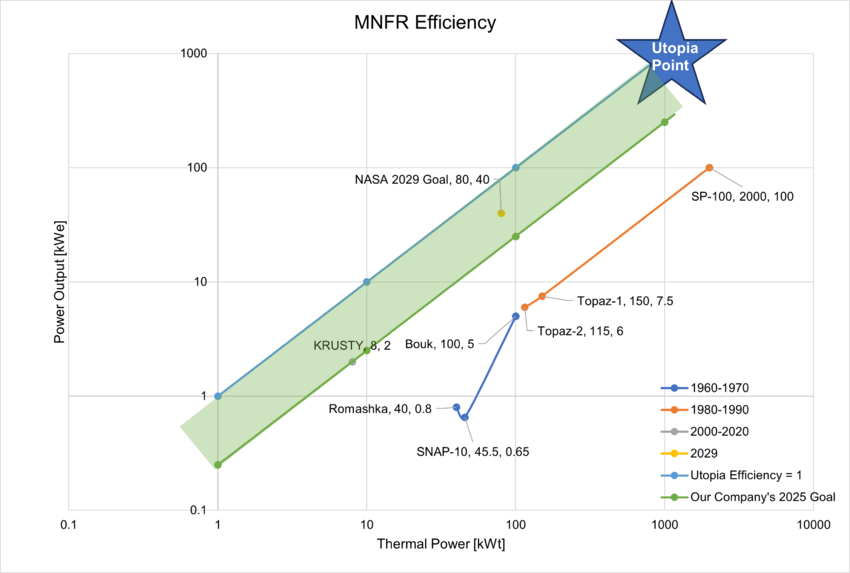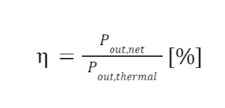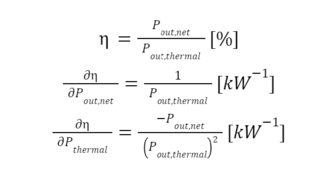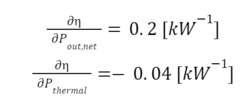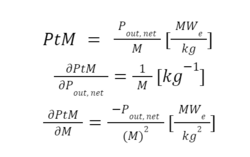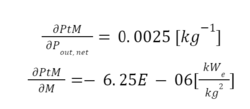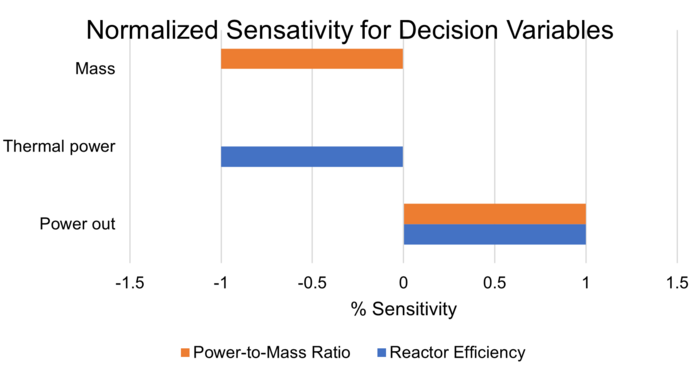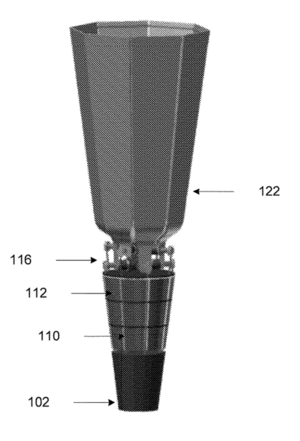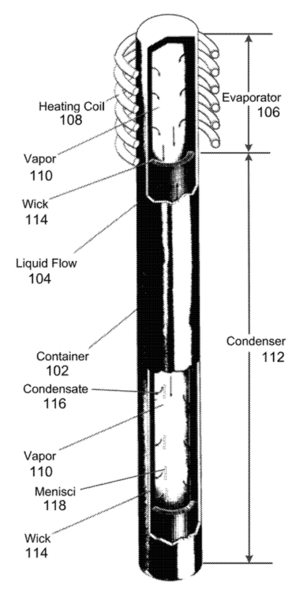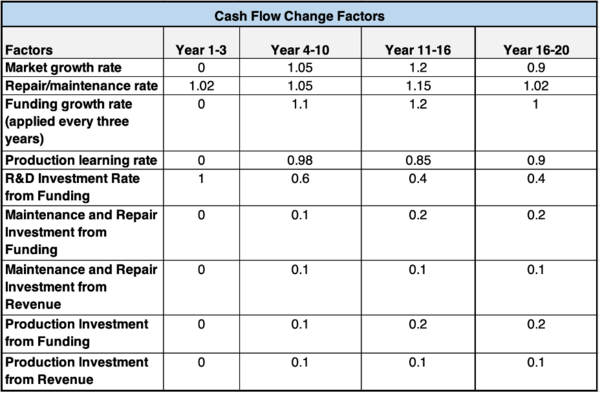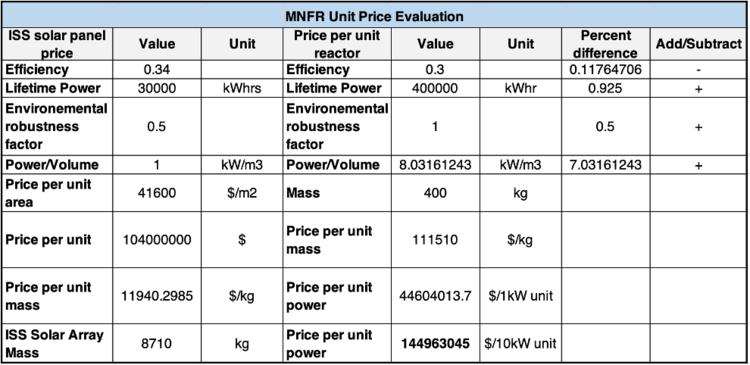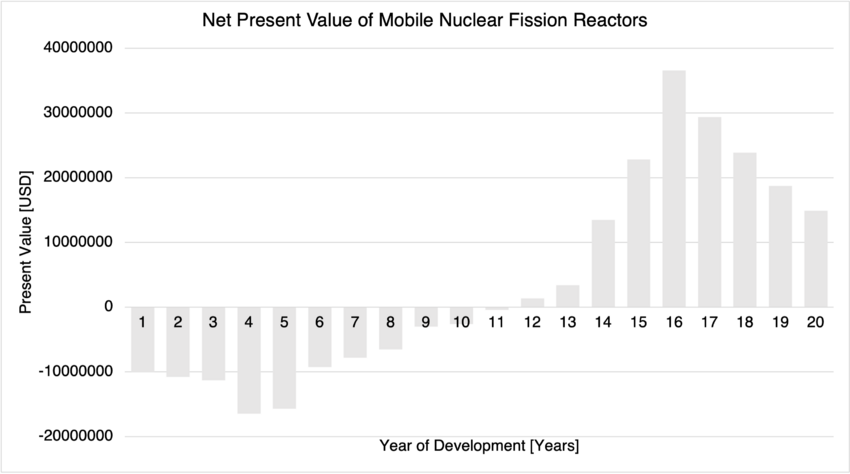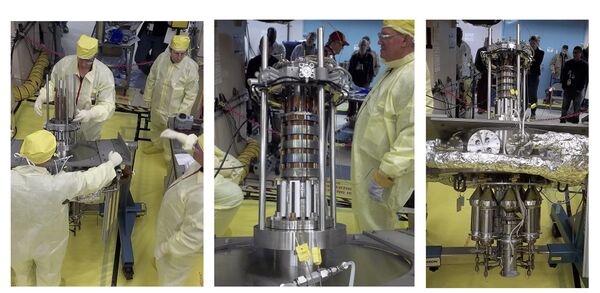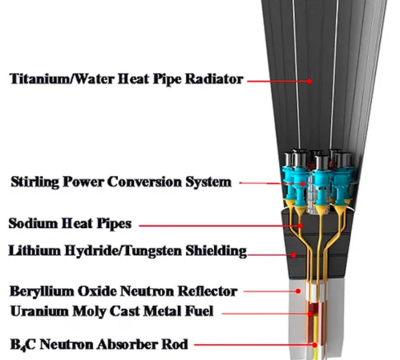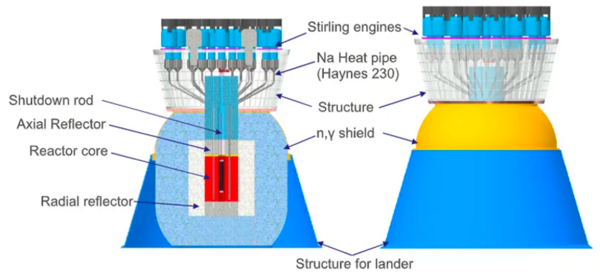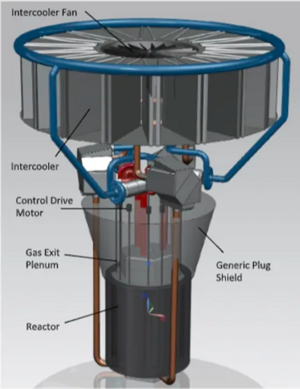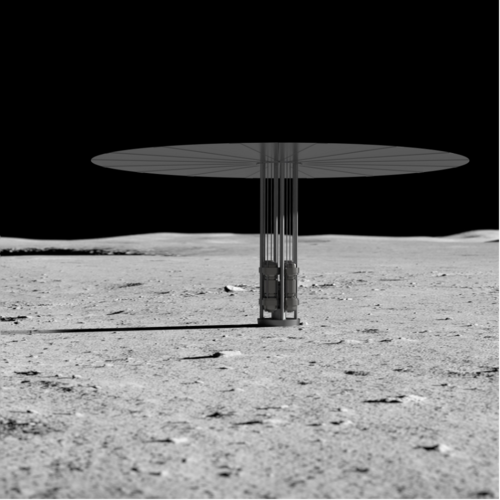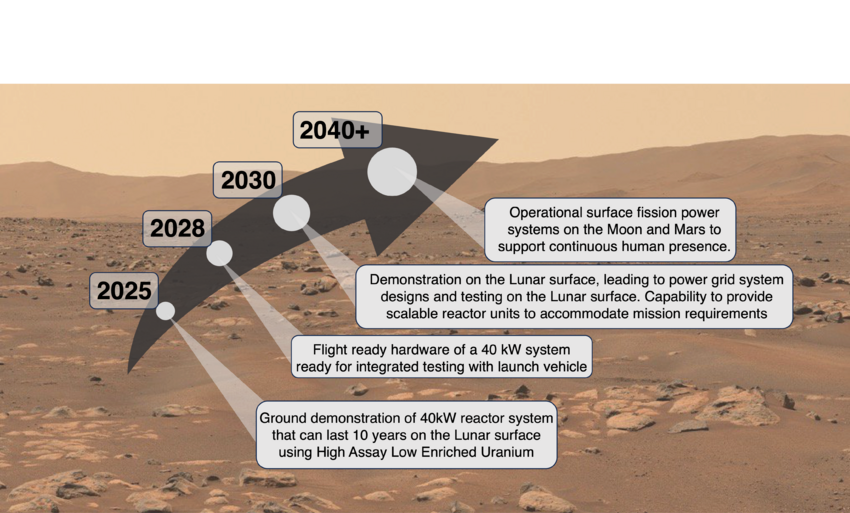Difference between revisions of "Mobile Nuclear Fission Reactors"
Tag: Manual revert |
|||
| (84 intermediate revisions by 2 users not shown) | |||
| Line 1: | Line 1: | ||
Roadmap Creators: [https://www.linkedin.com/in/yana-charoenboonvivat | Yana Charoenboonvivat], [https://www.linkedin.com/in/ireland-brown-ba5a60b5/ | Ireland Brown] | |||
=Roadmap Overview= | =Roadmap Overview= | ||
As humans venture further into space beyond low Earth orbit to establish settlements, there emerges a need for reliable power generation technologies for human settlements on other planets. While photovoltaics, fuel cells, batteries, and radioisotope thermoelectric generators (RTGs) are considered possible power sources, each have limitations within the scope of long duration missions that require higher loads and reliability to support human settlements. For example, solar arrays are highly dependent on the sun, meaning that it cannot generate power during night times. Batteries generally provide low power and have a short lifespan, making them unsuitable power sources for human settlements. As shown in the diagram below, the need for higher load powers and longer duration missions points to nuclear energy as a source of power for human settlements on other planets. The '''Mobile Nuclear Fission Reactor (MNFR)''' is a technology that can provide nuclear energy and will be the focus of this technology roadmap. It is important that we describe the nuclear fission reactor technology being roadmapped as being “Mobile” because it must be able to move freely and easily so that it can be transported from Earth to the planet via a launch vehicle. | As humans venture further into space beyond low Earth orbit to establish settlements, there emerges a need for reliable power generation technologies for human settlements on other planets. While photovoltaics, fuel cells, batteries, and radioisotope thermoelectric generators (RTGs) are considered possible power sources, each have limitations within the scope of long duration missions that require higher loads and reliability to support human settlements. For example, solar arrays are highly dependent on the sun, meaning that it cannot generate power during night times. Batteries generally provide low power and have a short lifespan, making them unsuitable power sources for human settlements. As shown in the diagram below, the need for higher load powers and longer duration missions points to nuclear energy as a source of power for human settlements on other planets. The '''Mobile Nuclear Fission Reactor (MNFR)''' is a technology that can provide nuclear energy and will be the focus of this technology roadmap. It is important that we describe the nuclear fission reactor technology being roadmapped as being “Mobile” because it must be able to move freely and easily so that it can be transported from Earth to the planet via a launch vehicle. | ||
| Line 6: | Line 7: | ||
Image taken from: https://ocw.mit.edu/courses/16-851-satellite-engineering-fall-2003/2c8a1a136db0e366ae8d1a1e2995a505_l3_scpowersys_dm_done2.pdf | Image taken from: https://ocw.mit.edu/courses/16-851-satellite-engineering-fall-2003/2c8a1a136db0e366ae8d1a1e2995a505_l3_scpowersys_dm_done2.pdf | ||
At high-level, nuclear fission reactors generate power through the nuclear fission chain reaction of fuel that is stored within the reactor core. The fuel contains fissile isotopes of elements such as uranium-235 and plutonium-239. The reactor core generates heat as a result of the chain reaction, and the heat is converted into kinetic energy and ultimately electrical energy that is distributed and used. Using nuclear fission reactors in extraterrestrial environments imposes constraints on the system which are inherently different from Earth-based reactor systems. Some examples of these constraints include the reactor size/mass (due to launch costs), safety, decommissioning, and cost of operations. This roadmap will allow us to project future nuclear fission reactor capabilities that we may potentially harness to generate power for future human settlements in space. | At high-level, nuclear fission reactors generate power through the nuclear fission chain reaction of fuel that is stored within the reactor core. The fuel contains fissile isotopes of elements such as uranium-235 and plutonium-239. The reactor core generates heat as a result of the chain reaction, and the heat is converted into kinetic energy and ultimately electrical energy that is distributed and used. Using nuclear fission reactors in extraterrestrial environments imposes constraints on the system which are inherently different from Earth-based reactor systems. Some examples of these constraints include the reactor size/mass (due to launch costs), safety, decommissioning, and cost of operations. Other challenges associated with deploying MNFRs include radiation shielding (to protect crew from radiation) and launch safety. This roadmap will allow us to project future nuclear fission reactor capabilities that we may potentially harness to generate power for future human settlements in space. | ||
=Design Structure Matrix (DSM) Allocation= | =Design Structure Matrix (DSM) Allocation= | ||
| Line 45: | Line 46: | ||
|} | |} | ||
===Other Figures of Merit Considered but Excluded=== | |||
'''Size/Mass Metric:''' Given the mobile nature of this product, it is predicted that in the future when production of MNFRs is more rapid and there is increased competition across industry players, that a size and weight figure of merit will emerge. This makes sense because it will be cheaper to transport a smaller and lighter MNFR on a rocket and/or cargo carrier spacecraft. However, in the present time, this figure of merit is not traceable, since only one of the past developed MNFRs have actually gone to space. The more important figure of merit that compares the power output per unit mass is the power-to-mass ratio, which is relevant since MNFRs are forecasted to be a disruption to current space power technologies- such as solar arrays- in this way. | |||
'''Cost Metric:''' While a cost metric is important to track over time to assess the feasibility of implementing space nuclear reactors, this metric was excluded for several reasons. Data available for the cost of past space reactors programs (9 programs in total, all terminated) shows a generally decreasing trend over time. However, this trend is largely due to the lack of funding over time, not due to improved technologies/capabilities. The space reactor program in the US has had a long-standing history of terminated programs. For example, in the past six decades, the US has only completed one space flight reactor (SNAP program during the 1960s-1970s) and tested 7 space reactors (6 from the SNAP project and 1 from Kilopower). | |||
==Stakeholder Objectives== | |||
It is important that the figures of merit selected are traceable to high-level stakeholder objectives which are shown below for different phases of a mission involving MNFRs to provide power for human habitats on other planetary surfaces: | It is important that the figures of merit selected are traceable to high-level stakeholder objectives which are shown below for different phases of a mission involving MNFRs to provide power for human habitats on other planetary surfaces: | ||
| Line 64: | Line 71: | ||
The table below describes each FOM mathematically and indicates which objective they are traceable to. It also discusses whether higher/lower values of each FOM indicate technological progress and how each FOM is related to the objective it traces. | The table below describes each FOM mathematically and indicates which objective they are traceable to. It also discusses whether higher/lower values of each FOM indicate technological progress and how each FOM is related to the objective it traces. | ||
[[File: | [[File:FOMTableFINAL.png|850px|center]] | ||
==Tracking FOMs over Time [dFOM/dt]== | |||
Background information and data was collected for the reactor efficiency FOM, which is described mathematically in the table above. Relevant data was collected for 11 space reactor power systems between the years 1964 to 2018 as shown below. | Background information and data was collected for the reactor efficiency FOM, which is described mathematically in the table above. Relevant data was collected for 11 space reactor power systems between the years 1964 to 2018 as shown below. | ||
[[File: | [[File:Fom1plotMNFR.png|700px|center]] | ||
'''Figure 1'''. Plot showing the reactor efficiency over time for eleven space reactor power systems. | '''Figure 1'''. Plot showing the reactor efficiency over time for eleven space reactor power systems. | ||
When a linear trend line is fitted to the data points, the equation yielded is: | When a linear trend line is fitted to the data points, the equation yielded is: | ||
| Line 185: | Line 89: | ||
===Theoretical limit=== | |||
The theoretical limit for reactor efficiency is '''0 < efficiency < 1'''. The lower bound limit of the scale where effiency = 0 suggests that none of the thermal power generated by the reactor is converted to electrical power. The upper bound limit of the scale where efficiency = 1 suggests that all the thermal power generated by the reactor is converted to electrical power. Due to the conservation of energy, it is theoretically not possible for effiency > 1 because this would indicate that energy is being produced in the process of converting a fixed amount of thermal energy to electrical energy. The efficiency also cannot be less than 0 because this indicates that energy is being consumed in the process of converting a fixed amount of thermal energy to electrical energy. We note that there is a limitation to the linear model shown in Figure 1 because it indicates that reactor efficiency can be greater than the theoretical upper bound of 1 in the far future. Thus, the linear model may only be valid to project reactor efficiency in the short term (e.g. 5-10 years ahead). | The theoretical limit for reactor efficiency is '''0 < efficiency < 1'''. The lower bound limit of the scale where effiency = 0 suggests that none of the thermal power generated by the reactor is converted to electrical power. The upper bound limit of the scale where efficiency = 1 suggests that all the thermal power generated by the reactor is converted to electrical power. Due to the conservation of energy, it is theoretically not possible for effiency > 1 because this would indicate that energy is being produced in the process of converting a fixed amount of thermal energy to electrical energy. The efficiency also cannot be less than 0 because this indicates that energy is being consumed in the process of converting a fixed amount of thermal energy to electrical energy. We note that there is a limitation to the linear model shown in Figure 1 because it indicates that reactor efficiency can be greater than the theoretical upper bound of 1 in the far future. Thus, the linear model may only be valid to project reactor efficiency in the short term (e.g. 5-10 years ahead). | ||
===Estimation of the Location in Technology Lifecycle=== | |||
One might argue that there is a complete S-curve relationship (i.e.the technology has reached “stagnation”) between the reactor efficiency over time as shown in Figure 2. | One might argue that there is a complete S-curve relationship (i.e.the technology has reached “stagnation”) between the reactor efficiency over time as shown in Figure 2. | ||
[[File: | [[File: FOM1SCURVE.png|700px|center]] | ||
'''Figure 2.''' Plot showing the reactor efficiency over time with a possible S-surve relationship | '''Figure 2.''' Plot showing the reactor efficiency over time with a possible S-surve relationship | ||
| Line 230: | Line 104: | ||
However, the upper asymptomatic limit that appears to occur at effiency = 0.25 is far below the theoretical upper bound of efficiency = 1. This could suggest that the improvements in reactor efficiency over time shown in Figure 2 are actually indicative of stepwise incremental progress in the FOM rather than an S-curve progression. In addition, the data collected is for only one FOM, meaning that it may not holistically track mobile nuclear reactor technology development over time. There is evidence that points to the mobile nuclear reactor technology being located in the “incubation” phase before reaching the “take–off” phase in the technology lifecycle (marked in red in Figure 3). | However, the upper asymptomatic limit that appears to occur at effiency = 0.25 is far below the theoretical upper bound of efficiency = 1. This could suggest that the improvements in reactor efficiency over time shown in Figure 2 are actually indicative of stepwise incremental progress in the FOM rather than an S-curve progression. In addition, the data collected is for only one FOM, meaning that it may not holistically track mobile nuclear reactor technology development over time. There is evidence that points to the mobile nuclear reactor technology being located in the “incubation” phase before reaching the “take–off” phase in the technology lifecycle (marked in red in Figure 3). | ||
[[File:MNFR - FOM1plot3.png|700px| | [[File:MNFR - FOM1plot3.png|700px|center]] | ||
'''Figure 3.''' S-curve of a technology with a red mark indicating where the mobile nuclear fission technology is located. Note that the S-curve diagram was obtained from Pg 108, Fig 4.15 of the Technology Roadmapping and Development textbook by Prof. Olivier de Weck | '''Figure 3.''' S-curve of a technology with a red mark indicating where the mobile nuclear fission technology is located. Note that the S-curve diagram was obtained from Pg 108, Fig 4.15 of the Technology Roadmapping and Development textbook by Prof. Olivier de Weck | ||
Between 1964 to 2018, which spans over 5 decades, fewer than 15 mobile nuclear reactors for space power systems were developed. Of the 11 reactor systems that data was collected for in this problem for this assignment, some systems were experimental and ground tested while some were launched and operational (hence the mobile nuclear reactor technology is past the “Initial Proof of Concept” phase). The lack of funding/interest that cut | Between 1964 to 2018, which spans over 5 decades, fewer than 15 mobile nuclear reactors for space power systems were developed. Of the 11 reactor systems that data was collected for in this problem for this assignment, some systems were experimental and ground tested while some were launched and operational (hence the mobile nuclear reactor technology is past the “Initial Proof of Concept” phase). The lack of funding/interest that cut many programs short (such as SAFE-400 and Topaz 2) and prevented them from progressing to flight tests, paired with data points that are too sparse to consistently show “rapid progress” indicates that the technology likely did not make it past the “take off” stage. | ||
=Alignment with Company Strategic Drivers: FOM Targets= | =Alignment with Company Strategic Drivers: FOM Targets= | ||
| Line 273: | Line 119: | ||
! Number !! Strategic Driver !! Alignment and Target | ! Number !! Strategic Driver !! Alignment and Target | ||
|- | |- | ||
| 1 || To develop a mobile nuclear fission reactor that can safely generate XkW of power for Y years | | 1 || Safe long duration electrical power generation: To develop a mobile nuclear fission reactor that can safely generate XkW of power for Y years | ||
|| The technology roadmap will target a mobile nuclear fission reactor that generates 10kW of power for 10 years. | || The technology roadmap will target a mobile nuclear fission reactor that generates 10kW of power for 10 years. | ||
| Line 281: | Line 127: | ||
|- | |- | ||
| 2 || To develop a mobile nuclear fission reactor that has a mass of less than Xkg per unit with a reactor efficiency of greater than Y%. || The technology roadmap will target a mobile nuclear fission reactor that has a mass less than 16,800kg per unit and a reactor efficiency of greater than 25%. | | 2 || Minimizing mass and maximizing efficiency: To develop a mobile nuclear fission reactor that has a mass of less than Xkg per unit with a reactor efficiency of greater than Y%. || The technology roadmap will target a mobile nuclear fission reactor that has a mass less than 16,800kg per unit and a reactor efficiency of greater than 25%. | ||
'''FOM Target''': Reactor Efficiency > 25% | '''FOM Target''': Reactor Efficiency > 25% | ||
| Line 296: | Line 142: | ||
[[File: | [[File:MNFRLifetimePareto2.png|850px|center]] | ||
[[File: | [[File:MNFREfficiencyPareto2.png|850px|center]] | ||
The UTOPIA point of lifetime energy is to have the highest power output for the longest duration. That of reactor efficiency, is a value of one, since this would mean 100% of the thermal energy released during the fission process is converted into electrical energy. Since the intention of current development of mobile nuclear fission reactors is to provide sufficient power for a crewed long duration space mission, the pareto front of lifetime energy as well as reactor efficiency is set by KRUSTY (Chapter 5, Figure 5-20). KRUSTY has the highest operational lifetime compared to previously developed MNFRs. Though the previously developed SP-100 has a high power output with an operational lifetime of 7 years, it was intended for short term military purposes, and as seen in the efficiency evaluation, is less efficient than KRUSTY. The earlier designs in the 1960s were also generally intended for military purposes, and though intended for longer operational lifetimes, when tested ran into various technical issues that ended up with system failure early on. NASA's goal is to be able to develop a reactor that would generate 40 kWe consistently for 10 years. These values are based on requirements developed for a hypothetical crewed Martian habitat that would need to be sustained for a 10 year mission. | The UTOPIA point of lifetime energy is to have the highest power output for the longest duration. That of reactor efficiency, is a value of one, since this would mean 100% of the thermal energy released during the fission process is converted into electrical energy. Since the intention of current development of mobile nuclear fission reactors is to provide sufficient power for a crewed long duration space mission, the pareto front of lifetime energy as well as reactor efficiency is set by KRUSTY (Chapter 5, Figure 5-20). KRUSTY has the highest operational lifetime compared to previously developed MNFRs. Though the previously developed SP-100 has a high power output with an operational lifetime of 7 years, it was intended for short term military purposes, and as seen in the efficiency evaluation, is less efficient than KRUSTY. The earlier designs in the 1960s were also generally intended for military purposes, and though intended for longer operational lifetimes, when tested ran into various technical issues that ended up with system failure early on. NASA's goal is to be able to develop a reactor that would generate 40 kWe consistently for 10 years by 2029. These values are based on requirements developed for a hypothetical crewed Martian habitat that would need to be sustained for a 10 year mission. That being said, our company's goal is to meet our targets based on our strategic drivers by 2025, as seen in the plot. For lifetime energy that it to develop a generator that produces 10 kWe consistently for 10 years, with an efficiency greater than 25%. | ||
=Technical Model: Morphological Matrix and Tradespace= | =Technical Model: Morphological Matrix and Tradespace= | ||
| Line 310: | Line 156: | ||
The most important Figure of Merit defining mobile nuclear fission reactors with respect to other electrical power generating technologies for space missions is lifetime energy. This is defined as, | The most important Figure of Merit defining mobile nuclear fission reactors with respect to other electrical power generating technologies for space missions is lifetime energy. This is defined as, | ||
[[File:LifetimeEquation.png| | [[File:LifetimeEquation.png|300px|center]] | ||
in which the defining variables are the net electrical power produced by the technology in megawatts, and the operational lifetime of the technology in hours, i.e., the number of hours that the technology may generate electrical power. | in which the defining variables are the net electrical power produced by the technology in megawatts, and the operational lifetime of the technology in hours, i.e., the number of hours that the technology may generate electrical power. | ||
| Line 318: | Line 164: | ||
This value directly translates to the capability of the MNFR design through the MNFR efficiency Figure of Merit, | This value directly translates to the capability of the MNFR design through the MNFR efficiency Figure of Merit, | ||
[[File:EfficiencyEquation.png| | [[File:EfficiencyEquation.png|225px|center]] | ||
The decision variables that directly affect the electrical power that may be generated from the nuclear fission is the percent of the uranium used in the fission process that is enriched, and the number of MNFR units that are then required based on this efficiency to generate the electrical power required by the mission. | The decision variables that directly affect the electrical power that may be generated from the nuclear fission is the percent of the uranium used in the fission process that is enriched, and the number of MNFR units that are then required based on this efficiency to generate the electrical power required by the mission. | ||
| Line 324: | Line 170: | ||
With respect to the number of required MNFR units to meet the power requirements, the mass of each unit becomes important when considering feasibility of the mission, i.e., the launch vehicle capability to bring over a number of the units given the amount of available payload mass. The percent enriched uranium also affects the fuel mass used which directly factors into the reactor mass. The mass and output electrical power directly factor into the power to mass ratio Figure of merit, | With respect to the number of required MNFR units to meet the power requirements, the mass of each unit becomes important when considering feasibility of the mission, i.e., the launch vehicle capability to bring over a number of the units given the amount of available payload mass. The percent enriched uranium also affects the fuel mass used which directly factors into the reactor mass. The mass and output electrical power directly factor into the power to mass ratio Figure of merit, | ||
[[File:PowerToMass.png| | [[File:PowerToMass.png|250px|center]] | ||
Using these equations, the following primary design decision variables have been selected. The option data is based on previous MNFR design data, all of which have been operated. | Using these equations, the following primary design decision variables have been selected. The option data is based on previous MNFR design data, all of which have been operated. | ||
[[File: | [[File:DecisionTable2.png|700px|center]] | ||
| Line 338: | Line 184: | ||
Solving for the analytical partial derivatives yield, | Solving for the analytical partial derivatives yield, | ||
[[File:EfficiencyAnalyticalDerivatives.png| | [[File:EfficiencyAnalyticalDerivatives.png|325px|center]] | ||
Using the design data for KRUSTY yields, | Using the design data for KRUSTY yields, | ||
[[File:KRUSTYDerivatives.png| | [[File:KRUSTYDerivatives.png|250px|center]] | ||
Normalizing these values yields, | Normalizing these values yields, | ||
[[File:KRUSTYEfficiencyNormal.png| | [[File:KRUSTYEfficiencyNormal.png|450px|center]] | ||
Figure of Merit: Power-to-Mass Ratio | Figure of Merit: Power-to-Mass Ratio | ||
Solving for the analytical partial derivatives yield, | Solving for the analytical partial derivatives yield, | ||
[[File:PowertoMassAnalytical.png| | [[File:PowertoMassAnalytical.png|250px|center]] | ||
Using the design data for KRUSTY yields, | Using the design data for KRUSTY yields, | ||
[[File:KRUSTYPowerDerivatives.png| | [[File:KRUSTYPowerDerivatives.png|250px|center]] | ||
Normalizing these values yields, | Normalizing these values yields, | ||
[[File:KRUSTYPowerNormal.png| | [[File:KRUSTYPowerNormal.png|450px|center]] | ||
[[File: | [[File:SensativityTornadoChart2.png|700px|center]] | ||
| Line 436: | Line 282: | ||
[[File:MNFRpatent2.png|300px|center]] | [[File:MNFRpatent2.png|300px|center]] | ||
This patent is relevant because it is a key component of mobile nuclear fission reactors (see Electric Fission Reactor for Space Applications patent) for use in space. Traditional Earth-based nuclear reactors such as Pressurized Water Reactors and Boiling Water Reactors transfer heat through the transfer of fluids (water) which require pumps and gravity to assist in the process. The use of pumps in a space environment is not ideal as pumps add additional complexity to the system (and can break and therefore require maintenance) and gravity on other planetary surfaces (such as the Moon and Mars) is not as strong as that on Earth. As a result, mobile heat pipes are a key technology to the development mobile nuclear fission reactors | This patent is relevant because it is a key component of mobile nuclear fission reactors (see Electric Fission Reactor for Space Applications patent) for use in space. Traditional Earth-based nuclear reactors such as Pressurized Water Reactors and Boiling Water Reactors transfer heat through the transfer of fluids (water) which require pumps and gravity to assist in the process. The use of pumps in a space environment is not ideal as pumps add additional complexity to the system (and can break and therefore require maintenance) and gravity on other planetary surfaces (such as the Moon and Mars) is not as strong as that on Earth. As a result, mobile heat pipes are a key technology to the development mobile nuclear fission reactors | ||
=Financial Model= | |||
Our financial model involves two major components: A cash flow chart and net present value (NPV) calculation over a 20 year project duration (assumed period). Due to a lack of historical data for the cost of space reactors (especially since the US has had only one flight test since the 1950s), our team hinges upon engineering estimates and parametric modeling to make predictions on the company’s cash flow and net present value. | |||
==Cash Flow== | |||
Below is a table showing the cash flow of our company for mobile space nuclear reactors. | |||
[[File:CashFlowMNFRFinal.png|1350px|center]] | |||
To understand how the cash flow table was constructed, we provide a table of “Cash flow change factors” between each of the twenty years to help understand how the numbers on the cash flow chart change over the course of 20 years. | |||
[[File:CashFlowChangeFactors.png|600px|center]] | |||
There are a couple of things that are important to note pertaining to the price per unit of the mobile nuclear fission reactors. KRUSTY, which was a prototype/test surface fission power unit required $20 million USD over three years to complete design, building, and testing. NASA is currently giving out 12 months, 5 million USD contracts. From this, we infer that NASA will likely not want to purchase a unit for more than what KRUSTY was produced at, so we set the per unit price to 20 million USD. We will assume that it takes our company four years to complete a space reactor concept and an additional 2 years to develop a unit that can be sold and put into operation (i.e. the first unit isn’t sold until year 6). At year 16, which is after the first unit sold has successfully operated for the expected 10 year lifetime, the price will increase to half the price computed based on technical merit ($72481522.26) (computed with respect to its improved performance relative to the International Space Station solar arrays as shown in the table below): | |||
[[File:MNFRunitPrice.png|750px|center]] | |||
Note: In the table above, we use the price of the ISS solar array as a baseline for price estimation of the mobile nuclear fission reactor at year 16 and onwards. Using the percentage differences between the performance of the solar array [from sources [18-31]) versus the KRUSTY reactor [23], the reactor cost was increased or decreased proportionally based on whether the reactor performance was an improvement or not from the solar array, respectively. | |||
==Net Present Value== | |||
With the shown cash flow chart and cash flow change factors, we have the resulting NPV chart shown below. We note that the company does not have positive NPV until year 12. | |||
[[File:NpvMNFR.png|850 px|center]] | |||
=List of R&T Projects and Prototypes (R&D portfolio)= | =List of R&T Projects and Prototypes (R&D portfolio)= | ||
| Line 461: | Line 331: | ||
==1-10 Kilowatt Electric HEU Space Reactor== | ==1-10 Kilowatt Electric HEU Space Reactor== | ||
[[File: 1-10kwSpaceNukes.png|400px|center]] | [[File: 1-10kwSpaceNukes.png|400px|center]] | ||
Image from [23] | |||
{| class="wikitable" | {| class="wikitable" | ||
|- | |- | ||
| Line 467: | Line 338: | ||
| '''FOMs Targeted''' || Power to Mass Ratio, Lifetime Energy, burn-up rate | | '''FOMs Targeted''' || Power to Mass Ratio, Lifetime Energy, burn-up rate | ||
|- | |- | ||
|'''Description'''|| This space reactor would be almost identical to the KRUSTY reactor which uses highly enriched uranium and has eight heat pipes attached to eight stirling engines. The designers believe that this design “could go decades without any control commands” and can be upscaled to produce 10kWe by increasing the mass from 400 kg to 1300kg. | |'''Description'''|| This space reactor would be almost identical to the KRUSTY reactor which uses highly enriched uranium and has eight heat pipes attached to eight stirling engines [23]. The designers believe that this design “could go decades without any control commands” and can be upscaled to produce 10kWe by increasing the mass from 400 kg to 1300kg [23]. | ||
|- | |- | ||
| Line 478: | Line 349: | ||
==10-30 Kilowatt Electric LEU Surface Reactor== | ==10-30 Kilowatt Electric LEU Surface Reactor== | ||
[[File: KilopowerM.png|600px|center]] | [[File: KilopowerM.png|600px|center]] | ||
Image from [23] | |||
{| class="wikitable" | {| class="wikitable" | ||
| Line 485: | Line 357: | ||
| '''FOMs Targeted''' || Power to Mass Ratio, Lifetime Energy, burn-up rate | | '''FOMs Targeted''' || Power to Mass Ratio, Lifetime Energy, burn-up rate | ||
|- | |- | ||
|'''Description'''|| TThis surface reactor project utilizes low enriched uranium (LEU) instead of highly enriched uranium (HEU) so that the power can be raised to 30kWe since using LEU helps to extend the fuel burnup. The power to weight ratio of this reactor is ~8kg/Watts, yielding a total mass of 3750kg | |'''Description'''|| TThis surface reactor project utilizes low enriched uranium (LEU) instead of highly enriched uranium (HEU) so that the power can be raised to 30kWe since using LEU helps to extend the fuel burnup. The power to weight ratio of this reactor is ~8kg/Watts, yielding a total mass of 3750kg [23] | ||
|- | |- | ||
| '''Timeline''' || Can be ready for flight in 4-5 years (~2027-2028) | | '''Timeline''' || Can be ready for flight in 4-5 years (~2027-2028) [23] | ||
|- | |- | ||
| '''Organizations/Companies Involved''' || Space Nuclear Power Corporation | | '''Organizations/Companies Involved''' || Space Nuclear Power Corporation | ||
| Line 495: | Line 367: | ||
==100-200 Kilowatt Electric LEU Surface Reactor== | ==100-200 Kilowatt Electric LEU Surface Reactor== | ||
[[File: KilopowerL.png|300px|center]] | [[File: KilopowerL.png|300px|center]] | ||
Image from [23] | |||
{| class="wikitable" | {| class="wikitable" | ||
|- | |- | ||
| Line 501: | Line 374: | ||
| '''FOMs Targeted''' || Power to Mass Ratio, Lifetime Energy | | '''FOMs Targeted''' || Power to Mass Ratio, Lifetime Energy | ||
|- | |- | ||
|'''Description'''|| To accommodate future increases in power demand on other planets/Moons, this space reactor concept aims to provide 100-200kWe of power. It will utilize around 2 metric tons of Uranium Oxide and has the ability to self-regulate like the KRUSTY/Kilopower reactor because it is a fast neutron reactor | |'''Description'''|| To accommodate future increases in power demand on other planets/Moons, this space reactor concept aims to provide 100-200kWe of power. It will utilize around 2 metric tons of Uranium Oxide and has the ability to self-regulate like the KRUSTY/Kilopower reactor because it is a fast neutron reactor [23] | ||
|- | |- | ||
| '''Timeline''' || “This reactor concept is in the conceptual design phase and would require more engineering before a valid schedule could be developed” [] | | '''Timeline''' || “This reactor concept is in the conceptual design phase and would require more engineering before a valid schedule could be developed” [23] | ||
|- | |- | ||
| '''Organizations/Companies Involved''' || Space Nuclear Power Corporation | | '''Organizations/Companies Involved''' || Space Nuclear Power Corporation | ||
| Line 511: | Line 384: | ||
==JETSON (Joint Emergent Technology Supplying On-Orbit Nuclear) High Power Program== | ==JETSON (Joint Emergent Technology Supplying On-Orbit Nuclear) High Power Program== | ||
[[File: JETSON.png|850px|center]] | [[File: JETSON.png|850px|center]] | ||
Image from [24] | |||
{| class="wikitable" | {| class="wikitable" | ||
|- | |- | ||
| Line 517: | Line 391: | ||
| '''FOMs Targeted''' || Not enough information available | | '''FOMs Targeted''' || Not enough information available | ||
|- | |- | ||
|'''Description'''|| JETSON is a program funded by the Air Force Research Laboratory that was awarded to Lockheed Martin, Intuitive Machines, and Westinghouse to “mature high-power nuclear electric power and propulsion technologies and spacecraft design”. JETSON aims to produce between 6kWe and 20kWe of electrical power and draws heavily from the KRUSTY/Kilopower design. | |'''Description'''|| JETSON is a program funded by the Air Force Research Laboratory that was awarded to Lockheed Martin, Intuitive Machines, and Westinghouse to “mature high-power nuclear electric power and propulsion technologies and spacecraft design”. JETSON aims to produce between 6kWe and 20kWe of electrical power and draws heavily from the KRUSTY/Kilopower design [24]. | ||
|- | |- | ||
| '''Timeline''' || Contractors are required to deliver their products by Dec 29th 2025 | | '''Timeline''' || Contractors are required to deliver their products by Dec 29th 2025 [25] | ||
|- | |- | ||
| '''Organizations/Companies Involved''' || Lockheed Martin, Air Force Research Laboratory, Space Nuclear Power Corp, Intuitive Machines, Westinghouse | | '''Organizations/Companies Involved''' || Lockheed Martin, Air Force Research Laboratory, Space Nuclear Power Corp, Intuitive Machines, Westinghouse [24] | ||
|- | |- | ||
|} | |} | ||
| Line 527: | Line 401: | ||
==NASA Fission Surface Power== | ==NASA Fission Surface Power== | ||
[[File: surfacefissionpower.png|500px|center]] | [[File: surfacefissionpower.png|500px|center]] | ||
Image from [26] | |||
{| class="wikitable" | {| class="wikitable" | ||
|- | |- | ||
| Line 533: | Line 408: | ||
| '''FOMs Targeted''' || Not enough information available | | '''FOMs Targeted''' || Not enough information available | ||
|- | |- | ||
|'''Description'''|| 12 month contracts each valued at approximately $5 million were awarded to three companies to develop initial design concepts for 40 kWe class fission power systems that can last at least 10 years on the Moon. These three companies include Lockheed Martin partnered with BWXT and Creare, Westinghouse partnered with Aerojet Rocketdyne, and IX (Joint Venture between Intuitive Machines and X-energy) partnered with Maxar and Boeing | |'''Description'''|| 12 month contracts each valued at approximately $5 million were awarded to three companies to develop initial design concepts for 40 kWe class fission power systems that can last at least 10 years on the Moon. These three companies include Lockheed Martin partnered with BWXT and Creare, Westinghouse partnered with Aerojet Rocketdyne, and IX (Joint Venture between Intuitive Machines and X-energy) partnered with Maxar and Boeing [26] | ||
Timeline: 12 months from June 2022 | Timeline: 12 months from June 2022 | ||
|- | |- | ||
| '''Timeline''' || 12 months from June 2022 | | '''Timeline''' || 12 months from June 2022 [26] | ||
|- | |- | ||
| '''Organizations/Companies Involved''' || NASA Glenn Research Center, NASA Marshall Space Flight Center, Lockheed Martin partnered with BWXT and Creare, Westinghouse partnered with Aerojet Rocketdyne, and IX (Joint Venture between Intuitive Machines and X-energy) partnered with Maxar and Boeing, Idaho National Laboratory | | '''Organizations/Companies Involved''' || NASA Glenn Research Center, NASA Marshall Space Flight Center, Lockheed Martin partnered with BWXT and Creare, Westinghouse partnered with Aerojet Rocketdyne, and IX (Joint Venture between Intuitive Machines and X-energy) partnered with Maxar and Boeing, Idaho National Laboratory [26] | ||
|- | |- | ||
| Line 544: | Line 419: | ||
=Technology Strategy Statement= | =Technology Strategy Statement= | ||
Our ultimate target is to provide mobile nuclear fission reactor units that can be part of a power grid to support continuous human presence on the Moon and eventually on Mars. To do so, we target to be able to demonstrate 40kW system that can last 10 years on the lunar surface using High Assay Low Enriched Uranium (HALEU) by 2025, which aligns with the goals of the NASA Fission Surface Power program that falls under the Artemis program umbrella. By 2028, which is ~5 years from the present day, we target to have flight-ready hardware that is ready for integrated testing with launch vehicles and lead to our first flight test. By ~2030, we aim to demonstrate our nuclear fission reactor system on the Lunar surface, which will lead to a power grid system design on the lunar surface. Our goal is to also provide scalable mobile nuclear fission reactors (by power output) to accommodate future mission requirements and power grid designs. By 2040 and beyond, our target is to have operational surface fission reactors that support continuous presence on the Moon and Mars. These targets are summarized and captured in the "Swoosh Chart" shown below. | |||
== Swoosh Chart == | |||
[[File: SwooshChart2.png|850px|center]] | |||
Background Image Taken from [27] | |||
=References= | =References= | ||
# https://en.wikipedia.org/wiki/Romashka_reactor | # https://en.wikipedia.org/wiki/Romashka_reactor | ||
| Line 571: | Line 451: | ||
# https://breakingdefense.com/2023/10/afrl-picks-3-contractors-for-jetson-effort-to-develop-fission-powered-spacecraft/ | # https://breakingdefense.com/2023/10/afrl-picks-3-contractors-for-jetson-effort-to-develop-fission-powered-spacecraft/ | ||
# https://www.nasa.gov/news-release/nasa-announces-artemis-concept-awards-for-nuclear-power-on-moon/ | # https://www.nasa.gov/news-release/nasa-announces-artemis-concept-awards-for-nuclear-power-on-moon/ | ||
# https://www.google.com/url?sa=i&url=https%3A%2F%2Fwww.caltech.edu%2Fabout%2Fnews%2Fthe-mysterious-origins-of-martian-meteorites&psig=AOvVaw12Kw4lAnoTag2WgaSxzMzE&ust=1700102147096000&source=images&cd=vfe&opi=89978449&ved=0CBIQjRxqFwoTCLjviJr8xIIDFQAAAAAdAAAAABAD | |||
# https://en.wikipedia.org/wiki/Electrical_system_of_the_International_Space_Station#:~:text=Each%20ISS%20solar%20array%20wing,cm%20square%20with%204%2C100%20diodes. | |||
# https://spaceflightnow.com/2022/12/03/iss-eva-82/#:~:text=NASA%20is%20upgrading%20the%20space,station's%20eight%20original%20solar%20panels. | |||
# https://www.nasa.gov/image-article/solar-arrays-international-space-station-2/#:~:text=The%20space%20station's%20solar%20arrays,area%20of%20a%20football%20field. | |||
# https://www.ccinnolab.org/solarcare/en/SolarAroundTheWorldPost/TheRollableSolarArrays#:~:text=They%20can%20hit%20around%2034,120%2C000%20watts)%20of%20augmented%20power. | |||
Latest revision as of 00:36, 5 December 2023
Roadmap Creators: | Yana Charoenboonvivat, | Ireland Brown
Roadmap Overview
As humans venture further into space beyond low Earth orbit to establish settlements, there emerges a need for reliable power generation technologies for human settlements on other planets. While photovoltaics, fuel cells, batteries, and radioisotope thermoelectric generators (RTGs) are considered possible power sources, each have limitations within the scope of long duration missions that require higher loads and reliability to support human settlements. For example, solar arrays are highly dependent on the sun, meaning that it cannot generate power during night times. Batteries generally provide low power and have a short lifespan, making them unsuitable power sources for human settlements. As shown in the diagram below, the need for higher load powers and longer duration missions points to nuclear energy as a source of power for human settlements on other planets. The Mobile Nuclear Fission Reactor (MNFR) is a technology that can provide nuclear energy and will be the focus of this technology roadmap. It is important that we describe the nuclear fission reactor technology being roadmapped as being “Mobile” because it must be able to move freely and easily so that it can be transported from Earth to the planet via a launch vehicle.
Image taken from: https://ocw.mit.edu/courses/16-851-satellite-engineering-fall-2003/2c8a1a136db0e366ae8d1a1e2995a505_l3_scpowersys_dm_done2.pdf
At high-level, nuclear fission reactors generate power through the nuclear fission chain reaction of fuel that is stored within the reactor core. The fuel contains fissile isotopes of elements such as uranium-235 and plutonium-239. The reactor core generates heat as a result of the chain reaction, and the heat is converted into kinetic energy and ultimately electrical energy that is distributed and used. Using nuclear fission reactors in extraterrestrial environments imposes constraints on the system which are inherently different from Earth-based reactor systems. Some examples of these constraints include the reactor size/mass (due to launch costs), safety, decommissioning, and cost of operations. Other challenges associated with deploying MNFRs include radiation shielding (to protect crew from radiation) and launch safety. This roadmap will allow us to project future nuclear fission reactor capabilities that we may potentially harness to generate power for future human settlements in space.
Design Structure Matrix (DSM) Allocation
The Mobile Nuclear Fission Reactor is identified to be a tier two technology because it is part of a wider initiative to develop power technologies (such as fuel cells, photovoltaics etc.) that can support in-space power systems for human habitats on other planetary surfaces. The Mobile Nuclear Fission Reactor (2-MNFR) is highlighted in dark green in the DSM below on the left. The MNFR is then broken down into two tier three systems which includes the containment and power conversion system. The containment and power conversion systems are then further broken down into tier four subsystems as summarized in the technology hierarchy tree below on the right.
The DSM highlights key dependencies between systems that make up the MNFR. Two notable observations could be made:
1.There is high interdependency between components that comprise the containment system and components that comprise the power conversion system. This is highlighted by the red boxes shown in the DSM. This outcome is expected because the tier four components in a reactor are designed to have a coupled relationship for the reactor to function
2. There is a high level of cross-system dependency between the containment system and power conversion system where the power conversion system receives “inputs” from the containment system. This outcome is expected because in a reactor, the power conversion system is downstream of the containment system (i.e.: the containment system produces thermal energy, and the power conversion system turns that into electrical energy). This cross-system interdependency is highlighted by the blue box shown in the DSM.
Roadmap Model using OPM
Shown below is an OPD of the Mobile Nuclear Fission Reactor system that was generated by OPCloud. The OPD captures the figures of merit, processes, and components involved with a MNFR. The key relationship to note from the OPD is that the containment system generates thermal energy and the power conversion system (which refers to the turbine generator system and thermal control system combined) converts the thermal energy to kinetic energy and then to electrical energy.
Figures of Merit (FOM)
The following FOMs were selected to track the technological progress of MNFRs over time.
| Figure of Merit | Units | Description |
|---|---|---|
| Reactor Efficiency | [%] | Proportion of electrical power generated from thermal power generated |
| Discharge Burnup | [MWd/kg] | Fission energy released in a day per unit mass of the fuel |
| Power to Mass Ratio | [MW/kg] | Electrical power generated per unit mass of the system |
| Reactor Reactivity Temperature Coefficient | [c/K] | Change in reactivity per degree Kelvin |
| Lifetime Energy | [MWhr] | Reactor net electrical power output multiplied by its lifetime in hours |
Other Figures of Merit Considered but Excluded
Size/Mass Metric: Given the mobile nature of this product, it is predicted that in the future when production of MNFRs is more rapid and there is increased competition across industry players, that a size and weight figure of merit will emerge. This makes sense because it will be cheaper to transport a smaller and lighter MNFR on a rocket and/or cargo carrier spacecraft. However, in the present time, this figure of merit is not traceable, since only one of the past developed MNFRs have actually gone to space. The more important figure of merit that compares the power output per unit mass is the power-to-mass ratio, which is relevant since MNFRs are forecasted to be a disruption to current space power technologies- such as solar arrays- in this way.
Cost Metric: While a cost metric is important to track over time to assess the feasibility of implementing space nuclear reactors, this metric was excluded for several reasons. Data available for the cost of past space reactors programs (9 programs in total, all terminated) shows a generally decreasing trend over time. However, this trend is largely due to the lack of funding over time, not due to improved technologies/capabilities. The space reactor program in the US has had a long-standing history of terminated programs. For example, in the past six decades, the US has only completed one space flight reactor (SNAP program during the 1960s-1970s) and tested 7 space reactors (6 from the SNAP project and 1 from Kilopower).
Stakeholder Objectives
It is important that the figures of merit selected are traceable to high-level stakeholder objectives which are shown below for different phases of a mission involving MNFRs to provide power for human habitats on other planetary surfaces:
Launch
[A] The system should target to have as low of a mass it can for the amount of power it can generate because launch costs are dependent on mass.
Operation
[B] The system should target to provide power for long periods of time without maintenance/resupply because maintenance/resupply capabilities are more costly and complex the farther the farther away the proposed habitat is from Earth.
[C] The system should be operated safely
End of Life
[D] The system should aim to have low waste production since nuclear waste is hard to manage.
The table below describes each FOM mathematically and indicates which objective they are traceable to. It also discusses whether higher/lower values of each FOM indicate technological progress and how each FOM is related to the objective it traces.
Tracking FOMs over Time [dFOM/dt]
Background information and data was collected for the reactor efficiency FOM, which is described mathematically in the table above. Relevant data was collected for 11 space reactor power systems between the years 1964 to 2018 as shown below.
Figure 1. Plot showing the reactor efficiency over time for eleven space reactor power systems.
When a linear trend line is fitted to the data points, the equation yielded is:
y = 0.0049x - 9.5428 with an R^2 value of 0.7061
The gradient of the trendline (0.0049) indicates that the linear rate of improvement is 0.49% per year. The R2 value of 0.7061 generally indicates a good fit of the linear model to the data.
Theoretical limit
The theoretical limit for reactor efficiency is 0 < efficiency < 1. The lower bound limit of the scale where effiency = 0 suggests that none of the thermal power generated by the reactor is converted to electrical power. The upper bound limit of the scale where efficiency = 1 suggests that all the thermal power generated by the reactor is converted to electrical power. Due to the conservation of energy, it is theoretically not possible for effiency > 1 because this would indicate that energy is being produced in the process of converting a fixed amount of thermal energy to electrical energy. The efficiency also cannot be less than 0 because this indicates that energy is being consumed in the process of converting a fixed amount of thermal energy to electrical energy. We note that there is a limitation to the linear model shown in Figure 1 because it indicates that reactor efficiency can be greater than the theoretical upper bound of 1 in the far future. Thus, the linear model may only be valid to project reactor efficiency in the short term (e.g. 5-10 years ahead).
Estimation of the Location in Technology Lifecycle
One might argue that there is a complete S-curve relationship (i.e.the technology has reached “stagnation”) between the reactor efficiency over time as shown in Figure 2.
Figure 2. Plot showing the reactor efficiency over time with a possible S-surve relationship
However, the upper asymptomatic limit that appears to occur at effiency = 0.25 is far below the theoretical upper bound of efficiency = 1. This could suggest that the improvements in reactor efficiency over time shown in Figure 2 are actually indicative of stepwise incremental progress in the FOM rather than an S-curve progression. In addition, the data collected is for only one FOM, meaning that it may not holistically track mobile nuclear reactor technology development over time. There is evidence that points to the mobile nuclear reactor technology being located in the “incubation” phase before reaching the “take–off” phase in the technology lifecycle (marked in red in Figure 3).
Figure 3. S-curve of a technology with a red mark indicating where the mobile nuclear fission technology is located. Note that the S-curve diagram was obtained from Pg 108, Fig 4.15 of the Technology Roadmapping and Development textbook by Prof. Olivier de Weck
Between 1964 to 2018, which spans over 5 decades, fewer than 15 mobile nuclear reactors for space power systems were developed. Of the 11 reactor systems that data was collected for in this problem for this assignment, some systems were experimental and ground tested while some were launched and operational (hence the mobile nuclear reactor technology is past the “Initial Proof of Concept” phase). The lack of funding/interest that cut many programs short (such as SAFE-400 and Topaz 2) and prevented them from progressing to flight tests, paired with data points that are too sparse to consistently show “rapid progress” indicates that the technology likely did not make it past the “take off” stage.
Alignment with Company Strategic Drivers: FOM Targets
Our company is planning to provide services to NASA to build mobile nuclear fission reactors to provide surface fission power for future settlements on other planetary surfaces like the Moon and Mars. The two key strategic drivers are shown in the table below. The first strategic driver is relevant to the mission objective provided by NASA, while the second strategic driver is focused on giving the company a competitive edge in the development of its mobile nuclear fission reactors.
| Number | Strategic Driver | Alignment and Target |
|---|---|---|
| 1 | Safe long duration electrical power generation: To develop a mobile nuclear fission reactor that can safely generate XkW of power for Y years | The technology roadmap will target a mobile nuclear fission reactor that generates 10kW of power for 10 years.
FOM Target: Lifetime Energy = 100kW years This driver is currently aligned with the 2MNFR technology roadmap. Positive results from the testing of KRUSTY demonstrates that the target power level for the target duration is possible within the strategic time frame [15]. In addition, the implementation of passive safety systems on these reactors and HALEU (High Assay Low Enriched Uranium) increases the safety of the reactors [16]. |
| 2 | Minimizing mass and maximizing efficiency: To develop a mobile nuclear fission reactor that has a mass of less than Xkg per unit with a reactor efficiency of greater than Y%. | The technology roadmap will target a mobile nuclear fission reactor that has a mass less than 16,800kg per unit and a reactor efficiency of greater than 25%.
FOM Target: Reactor Efficiency > 25% FOM Target: 10kW/16800kg = 0.5952 W/kg These target values will provide the company with a competitive edge and is currently aligned with the 2MNFR technology roadmap. KRUSTY had an overall system efficiency of ~25% and so a target reactor efficiency of >25% is desired [15]. According to SpaceX, the Falcon Heavy is capable of taking ~16,800kg of payload to Mars so having a mass less than 16,800kg opens the possibility of the reactor being transportable to Mars via Falcon Heavy and Starship (Starship can carry more payload mass than Falcon Heavy) [17]. Mars is selected because it is the “ultimate destination for permanent human presence, which provides the company with further competitive edge. |
Positioning of Company vs Competition: FOM Charts
The UTOPIA point of lifetime energy is to have the highest power output for the longest duration. That of reactor efficiency, is a value of one, since this would mean 100% of the thermal energy released during the fission process is converted into electrical energy. Since the intention of current development of mobile nuclear fission reactors is to provide sufficient power for a crewed long duration space mission, the pareto front of lifetime energy as well as reactor efficiency is set by KRUSTY (Chapter 5, Figure 5-20). KRUSTY has the highest operational lifetime compared to previously developed MNFRs. Though the previously developed SP-100 has a high power output with an operational lifetime of 7 years, it was intended for short term military purposes, and as seen in the efficiency evaluation, is less efficient than KRUSTY. The earlier designs in the 1960s were also generally intended for military purposes, and though intended for longer operational lifetimes, when tested ran into various technical issues that ended up with system failure early on. NASA's goal is to be able to develop a reactor that would generate 40 kWe consistently for 10 years by 2029. These values are based on requirements developed for a hypothetical crewed Martian habitat that would need to be sustained for a 10 year mission. That being said, our company's goal is to meet our targets based on our strategic drivers by 2025, as seen in the plot. For lifetime energy that it to develop a generator that produces 10 kWe consistently for 10 years, with an efficiency greater than 25%.
Technical Model: Morphological Matrix and Tradespace
Decision Variable Selection Based on Figures of Merit Governing Equations
The most important Figure of Merit defining mobile nuclear fission reactors with respect to other electrical power generating technologies for space missions is lifetime energy. This is defined as,
in which the defining variables are the net electrical power produced by the technology in megawatts, and the operational lifetime of the technology in hours, i.e., the number of hours that the technology may generate electrical power.
This is often set as a mission requirement. For example, NASA approximates that a human operated Martian habitat would require 40 kW of electrical power [10]. This is based on the number of years the astronauts expect to reside and conduct nominal operations on the Martian surface, and how much power is required to maintain the Martian facilities.
This value directly translates to the capability of the MNFR design through the MNFR efficiency Figure of Merit,
The decision variables that directly affect the electrical power that may be generated from the nuclear fission is the percent of the uranium used in the fission process that is enriched, and the number of MNFR units that are then required based on this efficiency to generate the electrical power required by the mission.
With respect to the number of required MNFR units to meet the power requirements, the mass of each unit becomes important when considering feasibility of the mission, i.e., the launch vehicle capability to bring over a number of the units given the amount of available payload mass. The percent enriched uranium also affects the fuel mass used which directly factors into the reactor mass. The mass and output electrical power directly factor into the power to mass ratio Figure of merit,
Using these equations, the following primary design decision variables have been selected. The option data is based on previous MNFR design data, all of which have been operated.
Sensitivity Analysis- Gradient Derivative Method and Tornado Chart
Based on the available data and the governing equations, a sensitivity analysis will be done for the reactor efficiency and power to mass ratio Figures of Merit. This will be done by analytically solving for the partial derivatives of the governing equations with respect to the decision variables and will then calculate the values using the design data for the KRUSTY MNFR as shown above. KRUSTY was selected since NASA tested the unit, and it is the most recent product undergoing development for the purpose of reaching NASA’s 2029 technical goal, which will enable long duration space travel. These values will then be normalized in order to observe the impact on the system performance in terms of percentage change that results from a one percent change in the design variable.
Figure of Merit: Reactor Efficiency Solving for the analytical partial derivatives yield,
Using the design data for KRUSTY yields,
Normalizing these values yields,
Figure of Merit: Power-to-Mass Ratio Solving for the analytical partial derivatives yield,
Using the design data for KRUSTY yields,
Normalizing these values yields,
The normalized values reveal that increasing the mass of the MNFR by one unit reduces the power-to-mass ratio by 1%. Increasing the thermal output by one unit reduces the reactor efficiency by 1%. Increasing the output power by one unit increases the power-to-mass ratio and reactor efficiency by 1%.
Key Publications and Patents
Publications
A subject matter expert from the Nuclear Science and Engineering department at MIT pointed the 2-MNFR team to eight articles from the Nuclear Technology journal that is about the most recent space nuclear reactor design, development and testing. These articles are crucial to the development of mobile nuclear fission reactors and the two key publications were selected as follows:
Title: KRUSTY Reactor Design
- Author(s): David I. Poston, Marc A. Gibson, Thomas Godfroy & Patrick R. McClure
- Published: 2020
- Journal: Nuclear Technology
Description and Relevance
This journal paper outlines KRUSTY (Kilowatt Reactor Using Stirling Technology) reactor design. The intention of KRUSTY is to demonstrate the operation of a Kilopower reactor system that provides electrical power on the order of one to ten kilowatts in space or on planetary surfaces. The paper covers design decisions that that allowed realistic cost and schedule (e.g. the use of fuels that can be acquired quickly and affordably, using existing technologies to assemble the reactor, and using and existing operational facility like the Nevada National Security Site), the prioritization of goals behind KRUSTY, KRUSTY requirements, modeling and simulation, and reactor design overview and components, and reactor design calculations.This paper is highly relevant to the development of mobile nuclear reactor technology for a number of reasons. The first is that it presents a novel reactor design that is the “first nuclear-powered operation of any truly new reactor concept in the United States in over 40 years”. In essence, one can view KRUSTY as the catalyst for the development of future mobile nuclear reactor technology for use in space, and this paper presents its design and development. In addition, KRUSTY demonstrates that space fission can be developed affordably and under a reasonable timeline; KRUSTY provides a baseline design and development process that works that future mobile nuclear reactors can take upon.
Title: Results of the KRUSTY Nuclear System Test
- Author(s): David I. Poston, Marc A. Gibson, Rene G. Sanchez, and Patrick R. McClure
- Published: 2020
- Journal: Nuclear Technology
Description and Relevance
This journal paper outlines the results of the KRUSTY nuclear system test. At a high level, the key takeaway is that “the system operated as expected and that the reactor is highly tolerant of failure conditions and transients” - the test was a success. The key outcomes of the system testing include: The overall system efficiency (ratio of electric power produced to thermal power produced) is at ~25% Nominal and off-nominal conditions were tested, and ultimately showed that the system can tolerate “worst case” conditions without needing active reactor control (i.e. the system can be operated passively) Heat pipes performed extremely well. The reactor was shown to be able to provide 10W to 4kW of fission power.
This paper is highly relevant to the development of mobile nuclear reactor technology because it demonstrates quantitatively that KRUSTY was a success and successfully demonstrated the first nuclear-powered operation of a novel reactor technology in the United States in over 40 years. Data collected from the testing can also be used to inform future mobile reactor design, which is highly valuable for the development of this technology. As the paper states, it can “hopefully breathe life into the nuclear power community as a whole”.
Patents
Initially, patents were searched for using the patent search process outlined in https://www.uspto.gov/learning-and-resources/support-centers/patent-and-trademark-resource-centers-ptrc/resources/seven from the U.S. Trademark and Patent Office. However, even after attempting to search for terms describing mobile nuclear fission reactors such as “Small nuclear reactor” or “Microreactor”, there were a lot of irrelevant patents. To narrow down the search, names of key authors of papers related to space nuclear reactors were searched for in the patents public search database instead. Conducting a literature review for space nuclear reactors informed the team of key authors in the field who are likely inventors of relevant patents. This patent search process yielded two key patents that are key to the mobile nuclear fission reactor technology.
Title: Electric Fission Reactor for Space Applications
- Date of Patent: April 30th 2019
- Inventors: Patrick Ray McClure, David Duff Dixon, David Irvin Poston, Lee Mason, Marc Gibson
- CPC Classification for Technology: G21C 1/02
Description and Relevance
This patent is for the design of a “power system utilizing a uranium-based reactor for space missions”. In other words, it is for a nuclear fission reactor that can be used in space. An example system, which includes a uranium fuel source to generate thermal energy, heat pipes to transfer thermal energy to stirling engine(s) to generate electricity, is shown below:
This is highly relevant to mobile nuclear fission reactors because the design resembles that of KRUSTY, which is a novel reactor technology that can set the path forward for future space nuclear reactors. In fact, the inventors were involved with the design and development of KRUSTY as part of the Kilopower program at NASA.
Title: Mobile Heat Pipe Cooled Fast Reactor System
- Date of Patent: November 26th 2020
- Inventors: Patrick Ray McClure, David Duff Dixon, David Irvin Poston, Richard J. Kapernick, Robert Stowers Reid, Venkateswara Rao Dasari
- CPC Classification for Technology: G21C 15/257 … using heat-pipes
Description and Relevance This patent is for a mobile heat pipe cooled fast reactor that may be able to provide 0.5 to 2 MW of power.
This patent is relevant because it is a key component of mobile nuclear fission reactors (see Electric Fission Reactor for Space Applications patent) for use in space. Traditional Earth-based nuclear reactors such as Pressurized Water Reactors and Boiling Water Reactors transfer heat through the transfer of fluids (water) which require pumps and gravity to assist in the process. The use of pumps in a space environment is not ideal as pumps add additional complexity to the system (and can break and therefore require maintenance) and gravity on other planetary surfaces (such as the Moon and Mars) is not as strong as that on Earth. As a result, mobile heat pipes are a key technology to the development mobile nuclear fission reactors
Financial Model
Our financial model involves two major components: A cash flow chart and net present value (NPV) calculation over a 20 year project duration (assumed period). Due to a lack of historical data for the cost of space reactors (especially since the US has had only one flight test since the 1950s), our team hinges upon engineering estimates and parametric modeling to make predictions on the company’s cash flow and net present value.
Cash Flow
Below is a table showing the cash flow of our company for mobile space nuclear reactors.
To understand how the cash flow table was constructed, we provide a table of “Cash flow change factors” between each of the twenty years to help understand how the numbers on the cash flow chart change over the course of 20 years.
There are a couple of things that are important to note pertaining to the price per unit of the mobile nuclear fission reactors. KRUSTY, which was a prototype/test surface fission power unit required $20 million USD over three years to complete design, building, and testing. NASA is currently giving out 12 months, 5 million USD contracts. From this, we infer that NASA will likely not want to purchase a unit for more than what KRUSTY was produced at, so we set the per unit price to 20 million USD. We will assume that it takes our company four years to complete a space reactor concept and an additional 2 years to develop a unit that can be sold and put into operation (i.e. the first unit isn’t sold until year 6). At year 16, which is after the first unit sold has successfully operated for the expected 10 year lifetime, the price will increase to half the price computed based on technical merit ($72481522.26) (computed with respect to its improved performance relative to the International Space Station solar arrays as shown in the table below):
Note: In the table above, we use the price of the ISS solar array as a baseline for price estimation of the mobile nuclear fission reactor at year 16 and onwards. Using the percentage differences between the performance of the solar array [from sources [18-31]) versus the KRUSTY reactor [23], the reactor cost was increased or decreased proportionally based on whether the reactor performance was an improvement or not from the solar array, respectively.
Net Present Value
With the shown cash flow chart and cash flow change factors, we have the resulting NPV chart shown below. We note that the company does not have positive NPV until year 12.
List of R&T Projects and Prototypes (R&D portfolio)
Although there have been a mobile fission reactor demonstration projects/research and development projects since the 1950s, we begin our list with the KRUSTY (Kilowatt Reactor Using Stirling Technology) design because it was the “first nuclear-powered operation of any truly new reactor concept in the United States in over 40 years"[]. Interest in space reactor projects have fluctuated in the past, but they have since re-emerged within the last decade due to increasing interest in establishing continuous human presence on other planets which will require surface fission power.
KRUSTY (Kilowatt Reactor Using Stirling Technology)
Image from [22]
| Type of R&D Project | Demonstrator |
| FOMs Targeted | Power to Mass Ratio, Lifetime Energy |
| Description | KRUSTY is a prototypic space nuclear fission reactor that uses highly enriched uranium and produces 1kWe of energy. The intent of the KRUSTY is to “demonstrate the nuclear operation of a Kilopower reactor”, which aims to provide 1-10kWe of power in space or on the surface of planets/Moons. KRUSTY successfully operated in March 2018 with positive test results |
| Timeline | Successful test and operation completed in March 2018 |
| Organizations/Companies Involved | NASA, Department of Energy, Los Alamos National Laboratory |
1-10 Kilowatt Electric HEU Space Reactor
Image from [23]
| Type of R&D Project | Research and Development |
| FOMs Targeted | Power to Mass Ratio, Lifetime Energy, burn-up rate |
| Description | This space reactor would be almost identical to the KRUSTY reactor which uses highly enriched uranium and has eight heat pipes attached to eight stirling engines [23]. The designers believe that this design “could go decades without any control commands” and can be upscaled to produce 10kWe by increasing the mass from 400 kg to 1300kg [23]. |
| Timeline | Can be ready for flight in three years (~2026) |
| Organizations/Companies Involved | Space Nuclear Power Corporation |
10-30 Kilowatt Electric LEU Surface Reactor
Image from [23]
| Type of R&D Project | Research and Technology |
| FOMs Targeted | Power to Mass Ratio, Lifetime Energy, burn-up rate |
| Description | TThis surface reactor project utilizes low enriched uranium (LEU) instead of highly enriched uranium (HEU) so that the power can be raised to 30kWe since using LEU helps to extend the fuel burnup. The power to weight ratio of this reactor is ~8kg/Watts, yielding a total mass of 3750kg [23] |
| Timeline | Can be ready for flight in 4-5 years (~2027-2028) [23] |
| Organizations/Companies Involved | Space Nuclear Power Corporation |
100-200 Kilowatt Electric LEU Surface Reactor
Image from [23]
| Type of R&D Project | Research and Technology |
| FOMs Targeted | Power to Mass Ratio, Lifetime Energy |
| Description | To accommodate future increases in power demand on other planets/Moons, this space reactor concept aims to provide 100-200kWe of power. It will utilize around 2 metric tons of Uranium Oxide and has the ability to self-regulate like the KRUSTY/Kilopower reactor because it is a fast neutron reactor [23] |
| Timeline | “This reactor concept is in the conceptual design phase and would require more engineering before a valid schedule could be developed” [23] |
| Organizations/Companies Involved | Space Nuclear Power Corporation |
JETSON (Joint Emergent Technology Supplying On-Orbit Nuclear) High Power Program
Image from [24]
| Type of R&D Project | Research and Technology |
| FOMs Targeted | Not enough information available |
| Description | JETSON is a program funded by the Air Force Research Laboratory that was awarded to Lockheed Martin, Intuitive Machines, and Westinghouse to “mature high-power nuclear electric power and propulsion technologies and spacecraft design”. JETSON aims to produce between 6kWe and 20kWe of electrical power and draws heavily from the KRUSTY/Kilopower design [24]. |
| Timeline | Contractors are required to deliver their products by Dec 29th 2025 [25] |
| Organizations/Companies Involved | Lockheed Martin, Air Force Research Laboratory, Space Nuclear Power Corp, Intuitive Machines, Westinghouse [24] |
NASA Fission Surface Power
Image from [26]
| Type of R&D Project | Research and Technology |
| FOMs Targeted | Not enough information available |
| Description | 12 month contracts each valued at approximately $5 million were awarded to three companies to develop initial design concepts for 40 kWe class fission power systems that can last at least 10 years on the Moon. These three companies include Lockheed Martin partnered with BWXT and Creare, Westinghouse partnered with Aerojet Rocketdyne, and IX (Joint Venture between Intuitive Machines and X-energy) partnered with Maxar and Boeing [26]
Timeline: 12 months from June 2022 |
| Timeline | 12 months from June 2022 [26] |
| Organizations/Companies Involved | NASA Glenn Research Center, NASA Marshall Space Flight Center, Lockheed Martin partnered with BWXT and Creare, Westinghouse partnered with Aerojet Rocketdyne, and IX (Joint Venture between Intuitive Machines and X-energy) partnered with Maxar and Boeing, Idaho National Laboratory [26] |
Technology Strategy Statement
Our ultimate target is to provide mobile nuclear fission reactor units that can be part of a power grid to support continuous human presence on the Moon and eventually on Mars. To do so, we target to be able to demonstrate 40kW system that can last 10 years on the lunar surface using High Assay Low Enriched Uranium (HALEU) by 2025, which aligns with the goals of the NASA Fission Surface Power program that falls under the Artemis program umbrella. By 2028, which is ~5 years from the present day, we target to have flight-ready hardware that is ready for integrated testing with launch vehicles and lead to our first flight test. By ~2030, we aim to demonstrate our nuclear fission reactor system on the Lunar surface, which will lead to a power grid system design on the lunar surface. Our goal is to also provide scalable mobile nuclear fission reactors (by power output) to accommodate future mission requirements and power grid designs. By 2040 and beyond, our target is to have operational surface fission reactors that support continuous presence on the Moon and Mars. These targets are summarized and captured in the "Swoosh Chart" shown below.
Swoosh Chart
Background Image Taken from [27]
References
- https://en.wikipedia.org/wiki/Romashka_reactor
- https://beyondnerva.wordpress.com/tag/bes-5/#:~:text=The%20first%20BES%2D5%20to,launched%20on%2025%20December%201971).
- https://www.osti.gov/servlets/purl/10184691
- https://inis.iaea.org/search/search.aspx?orig_q=RN:20046219
- https://fti.neep.wisc.edu/fti.neep.wisc.edu/neep602/SPRING00/lecture35.pdf
- https://pubs.aip.org/aip/acp/article/608/1/578/568965/Design-and-analysis-of-the-SAFE-400-space-fission
- https://pubs.aip.org/aip/acp/article/608/1/578/568965/Design-and-analysis-of-the-SAFE-400-space-fission
- https://world-nuclear.org/information-library/non-power-nuclear-applications/transport/nuclear-reactors-for-space.aspx
- https://ntrs.nasa.gov/api/citations/20205009350/downloads/03-KRUSTY%20Reactor%20Design.pdf
- https://ntrs.nasa.gov/api/citations/20160014032/downloads/20160014032.pdf
- https://watermark.silverchair.com/578_1_online.pdf?token=AQECAHi208BE49Ooan9kkhW_Ercy7Dm3ZL_9Cf3qfKAc485ysgAABW0wggVpBgkqhkiG9w0BBwagggVaMIIFVgIBADCCBU8GCSqGSIb3DQEHATAeBglghkgBZQMEAS4wEQQMzkR8c5zIbsawQuJiAgEQgIIFIElva-KinjjKc4FbjWcndk5ag0ijNkLrO0aw4Mpi8UGlS9auSdB2dQ6G_-jCqDrazbj8Rs7HAcqYWJf7xbDGQDIGdYYGLHIvoUW5Jn99UOcTiQKHAyJLAm6hK9KCipx4OUCRGFPvPxdHkxG0fXwHvlJ10Wa8lT3e1WZFk2QZddBWiDkkJtRAUKpWO8nJBQrGLCGeKGmpYgcX0pXDYNPxTN8DlHwP0YpVzrjUQkq-I-dlI-ecgs9zfXoP26aUGxo2-vX1HCPw7WyPlyBUEPowyhcxRKXxxqoaCO1DX61aUUV3Lh7NV3UcnbF82EnQUZowPjcHDyt2ttzXo_5pzODg0-h0yg3UKVRJKKAhwOvbIUsFL6nfZ0b-hiwtDi2GtbkXdtXppgXgBhEJc-v8kqJwW5VI0_BKV94SXJ2HxVQN002I0W6RWR1v9FAJdjR8DJXW710swYH_b_0SvCs3mMO-ExrGSNTbRW7WGEI1Pk-3uGg1WOEEwjgfOsMS2UP9A9ANJpOIPD32dZjW2Ja1sseDOsNhhBbuYO6zBRKccnv-7x_muuXT3dVFxIPYunz1BqM_TA4I-E4KWNu2ud7MhKD5WBEGXV9V5D1mxLvN5YmBNkQp5DiBZ8vUY4pdhH8AbH_8oSoXHBJ087vo8HRxFJ8psUNKf5yZTONZP9ujYCXLgKqkcRCO9ay2ID5ujejJEMGww0wyRD91tFU_HY-45wrn57HG7KGCvzhFoew_-22FmBaEnsM_eusVHS_W22y6y4sNSQlC7c2M84zV3IpTJUcMpE4FT6F-NRbGTaO79emUx9GSAUIxlKfGl1dk04wAzF2yi4Z3u9_ivXchrTI9D4l2m46a6opwv7QpVvJ37jVTZv_toa6MffGT9B0zdhXGROpSSKYKxh0MoK8tGFXYalDI-9ighRhO1ej5J-9mYH5AdYkXKGaoWrBlgURm3UrjF5mNCJY8C7TiFvljWtZ0g59EIMma1OfqZRKDMXUm4iTQE9Xy1uvB6enV1ywFanbZ4ETR_Qr59lnHZX8HsL3DwoWeEpkEFtFiqxc_aF-ngVrjgp94161V_iWyRddniTuDTExWXBtZDAuhOLkaehV7UgNdrGQW2MYveSSGeGUpnueswpSoRed_wQnXWMKprABxu9z9HqWcuzy_pt8Ssfac36XVsvbVMlE48jg2PynBu13hEqEjOY0zJymkhFiEQCMaKgXutG-kwk7o0KL2CJDXee1uHw45_fjD5pSD5unNYj5RYfkb1mrmslKPT81pb6SsPsXw1FSELf8JTzEPgpojuHUljFk54q7NjLzFCi5cwtpEAZJWB0_cjbY-AjTVdwv8EVBgNbuKQEVVU7UCchJuhF0mmddRJCP6rMxOqt8hT-CSLxypdMsFDVMbiqtVYUkWvX7_ofAKMUS_OqPcv3QgUjesvY3tLoW2Ps3KL9KwGIZjuzRl8ORoqQc0RbLRs5Gql870bAjZi37XN8c0gt94ObXE9LRgp8ilOcUdiGu2t1LiDqzvy0RSpLb13LdPA_u9xKIiuRG0b1bHyfKOhq4OtNyIk9EVeAio4YZtDDvmc_3aPnc7RCW483L2E4rm0_RG9AaJ2kBpk5dwaCcIFHFrJO06pLBMerkDvzbPSsjcwsm4iUNH7JDru4mKsCFiZ6kBoychdyhtrI-91JNi_r_lFeAaoUaA-YEsLjJgd6_-2zFMVyy3VFBy58y_2Kn6wn5eyH0-4u5JY6qJ4qlbhTuKtcLJQM4
- https://inis.iaea.org/collection/NCLCollectionStore/_Public/25/040/25040534.pdf?r=1
- https://fti.neep.wisc.edu/fti.neep.wisc.edu/neep602/SPRING00/lecture35.pdf
- https://ntrs.nasa.gov/api/citations/20205009350/downloads/03-KRUSTY%20Reactor%20Design.pdf
- https://www.spacenukes.com/_files/ugd/a08fa5_d80cff354b3d463ebd0a9aac74f5f1d0.pdf
- https://www.westinghousenuclear.com/energy-systems/evinci-microreactor
- https://www.spacex.com/vehicles/falcon-heavy/
- https://www.spacenukes.com/_files/ugd/a08fa5_8dbd0a5118b54b23922f4ba0d875317e.pdf
- https://www.spacenukes.com/_files/ugd/a08fa5_d80cff354b3d463ebd0a9aac74f5f1d0.pdf
- https://image-ppubs.uspto.gov/dirsearch-public/print/downloadPdf/10276271
- https://image-ppubs.uspto.gov/dirsearch-public/print/downloadPdf/11515053
- https://i0.wp.com/newspaceeconomy.ca/wp-content/uploads/2023/06/kilopower_media_event_charts_16x9_final-3-09.jpg?fit=7999%2C3912&ssl=1
- https://www.spacenukes.com/products
- https://www.lockheedmartin.com/en-us/news/features/2023/lockheed-martin-jets-into-nuclear-electrical-spacecraft-power.html
- https://breakingdefense.com/2023/10/afrl-picks-3-contractors-for-jetson-effort-to-develop-fission-powered-spacecraft/
- https://www.nasa.gov/news-release/nasa-announces-artemis-concept-awards-for-nuclear-power-on-moon/
- https://www.google.com/url?sa=i&url=https%3A%2F%2Fwww.caltech.edu%2Fabout%2Fnews%2Fthe-mysterious-origins-of-martian-meteorites&psig=AOvVaw12Kw4lAnoTag2WgaSxzMzE&ust=1700102147096000&source=images&cd=vfe&opi=89978449&ved=0CBIQjRxqFwoTCLjviJr8xIIDFQAAAAAdAAAAABAD
- https://en.wikipedia.org/wiki/Electrical_system_of_the_International_Space_Station#:~:text=Each%20ISS%20solar%20array%20wing,cm%20square%20with%204%2C100%20diodes.
- https://spaceflightnow.com/2022/12/03/iss-eva-82/#:~:text=NASA%20is%20upgrading%20the%20space,station's%20eight%20original%20solar%20panels.
- https://www.nasa.gov/image-article/solar-arrays-international-space-station-2/#:~:text=The%20space%20station's%20solar%20arrays,area%20of%20a%20football%20field.
- https://www.ccinnolab.org/solarcare/en/SolarAroundTheWorldPost/TheRollableSolarArrays#:~:text=They%20can%20hit%20around%2034,120%2C000%20watts)%20of%20augmented%20power.
